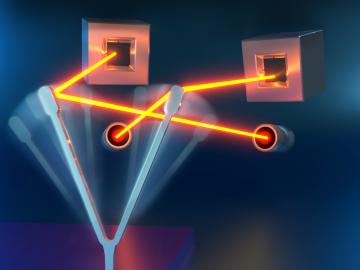
Filter News
Area of Research
News Topics
- (-) Artificial Intelligence (20)
- (-) Coronavirus (25)
- (-) Exascale Computing (5)
- (-) Nanotechnology (23)
- (-) Quantum Science (24)
- (-) Security (5)
- 3-D Printing/Advanced Manufacturing (43)
- Advanced Reactors (21)
- Big Data (18)
- Bioenergy (22)
- Biology (5)
- Biomedical (27)
- Biotechnology (3)
- Buildings (1)
- Chemical Sciences (5)
- Clean Water (7)
- Composites (3)
- Computer Science (74)
- Critical Materials (2)
- Cybersecurity (9)
- Energy Storage (29)
- Environment (48)
- Frontier (3)
- Fusion (18)
- Grid (12)
- High-Performance Computing (3)
- Isotopes (9)
- Machine Learning (13)
- Materials (2)
- Materials Science (57)
- Mathematics (2)
- Mercury (2)
- Microscopy (13)
- Molten Salt (3)
- National Security (2)
- Neutron Science (56)
- Nuclear Energy (48)
- Physics (19)
- Polymers (9)
- Space Exploration (6)
- Summit (26)
- Transportation (27)
Media Contacts
A team of scientists led by Oak Ridge National Laboratory found that while all regions of the country can expect an earlier start to the growing season as temperatures rise, the trend is likely to become more variable year-over-year in hotter regions.

Rigoberto “Gobet” Advincula has been named Governor’s Chair of Advanced and Nanostructured Materials at Oak Ridge National Laboratory and the University of Tennessee.

A team from the ORNL has conducted a series of experiments to gain a better understanding of quantum mechanics and pursue advances in quantum networking and quantum computing, which could lead to practical applications in cybersecurity and other areas.

Liam Collins was drawn to study physics to understand “hidden things” and honed his expertise in microscopy so that he could bring them to light.

A typhoon strikes an island in the Pacific Ocean, downing power lines and cell towers. An earthquake hits a remote mountainous region, destroying structures and leaving no communication infrastructure behind.

Scientists at have experimentally demonstrated a novel cryogenic, or low temperature, memory cell circuit design based on coupled arrays of Josephson junctions, a technology that may be faster and more energy efficient than existing memory devices.

Researchers across the scientific spectrum crave data, as it is essential to understanding the natural world and, by extension, accelerating scientific progress.

For nearly three decades, scientists and engineers across the globe have worked on the Square Kilometre Array (SKA), a project focused on designing and building the world’s largest radio telescope. Although the SKA will collect enormous amounts of precise astronomical data in record time, scientific breakthroughs will only be possible with systems able to efficiently process that data.

Students often participate in internships and receive formal training in their chosen career fields during college, but some pursue professional development opportunities even earlier.

Researchers at ORNL and the National Renewable Energy Laboratory took inspiration from flying insects to demonstrate a miniaturized gyroscope, a special sensor used in navigation technologies.


